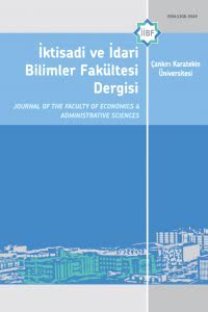Baskınlık ve Sosyal Seçim Kurallarına Bağlı Çok Kriterli Modelleme: Hisse Senedi Seçimi Problemi için bir Karar Destek Sistemi Önerisi
Multi Criterial Modelling based on Dominance and Social Choice Rules: A DSS Proposal for Stock Selection Problem
Multi Criteria Decision Making, Dominance Relations, Social Choice Models Stock Selection,
___
- Aizerman, M. ve Aleskerov, F. (1995), Theory of Choice, Elsevier Science B.V. Aleskerov, F. ve Çınar, Y. (2008) «q-Pareto-Scalar» Two-Stage Extremization Model and its Reducibility to One-Stage Model, Theory and Decision, 65(4):325-338.
- Aleskerov, F., Ersel, H. ve Yolalan (2004). R. Multicriterial ranking approach for evaluating bank branch performance. International journal of information technology & decision making, 3(2), 321-335.
- Aleskerov, F., Mitichkin, E. Shvydun, S. ve Yakuba, V. (2013). Super-threshold Procedures and Their Application to the Search Problem. Procedia Computer Science, 17, 1121-1124.
- Apesteguia, J. ve Ballester, M. A. (2013). Choice by sequential procedures. Games and Economic Behavior, 77(1), 90–99.
- Beach, L.R. (1993). Broadening the Definition of Decision Making: The Role of Prechoice Screening of Options Psychological Science, 4:215-220.
- Bouyssou, D. (2001). "Outranking Methods" in C.A. Floudas, P.M. Pardalos (Eds.), Encyclopedia of Optimization, Kluwer, 1-12.
- Borcherding, K., Eppel T. ve D. Von Winterfeldt (1991). "Comparison of Weighting Judgements in Multiattribute Utility Measurement, Management Science, 37(12): 1608.
- Borcherding, K., Schmeer, S. ve Weber M. (1995). "Biases in Multiattribute Weight Elicitation", in J.P. Caverni, M. Bar- Hillel, F.H. Baron & H. Jungermann (Eds.), Contrubitions to Decision Making-I, Elseiver Science B.V., 3-28.
- Deng, H., Yeh, C.H. ve Willis, R.J. (2000). "Inter-company comparison using modified TOPSIS with objective weights", Computers & Operations Research, 27: 963-973.
- Fishburn, P. C., ve Gehrlein, W. V. (1976). Borda's rule, positional voting, and Condorcet's simple majority principle. Public Choice, 28(1), 79-88.
- Garcia-Sanz, M. D. ve Alcantud, J. C. R. (2015). Sequential rationalization of multivalued choice. Mathematical Social Sciences, 74, 29-33.
- Gensch, D.H. A Two-Stage Disaggregate Attribute Choice Model (1987). Marketing Science, 6(3):223-239.
- Hogarth, R.M. ve Karelaia N. (2005) Simple Models for Multiattribute Choice with Many Alternatives: When It Does and Does Not Pay to Face Tradeoffs with Binary Attributes, Management Science, 2005, 51 (12): 1860- 1872.
- Langville, Amy N ve Meyer, Carl.D. (2006). Google’s PageRank and Beyond, The Science of Search Engine Rankings, Princeton University Press.
- Manzini, P. ve Mariotti, M. (2007). Sequentially rationalizable choice. Am. Econ. Rev.97 (5), 1824–1839.
- Manzini, P. ve Mariotti, M., (2011). Choice by lexicographic semiorders. Theor. Econ.7, 1–23.
- Manzini, P. ve Mariotti, M., (2012). Categorize then choose: boundedly rational choice and welfare. J. Eur. Econ. Assoc.10 (5), 1141–1165.
- Matriks Veri Terminali Kullanım Kılavuzu, Versiyon 7.0.3, 2.5.2013, Matriks Bilgi Dağıtım Hizmetleri A.Ş., https://www.matriksdata.com/website/kurumsal-urunler/matriks-veriterminali/dokumanlar/matriks-veri-terminali-kullanim-kilavuzu Erişim Tarihi: 30.7.2018.
- Moulin, H. (1991). Axioms of cooperative decision making (No. 15). Cambridge university press.
- Nelson, B.L., Swann, J. ve Goldsman, D. (2011). Simple procedures for selecting the best simulated system when the number of alternatives is large, Operations Research, 49(6): 950-963.
- Opricovic, S., ve Tzeng, G. H. (2004). Compromise solution by MCDM methods: A comparative analysis of VIKOR and TOPSIS. European journal of operational research, 156(2), 445-455.
- Roberts, R. ve Goodwin P., (2003). “Weight Approximations in Multi-Attribute Decision Models”, Journal of Multi-Criteria Decision Analysis, 11 (6): 291- 303.
- Roy, B. (1996). Multicriteria Methodology for Decision Aiding. Springer Science & Business Me Simon, H. A. (1972). Theories of Bounded Rationality. In Decision and Organizations. North-Holand Publishing Company.
- Saaty, T. L., (1980). The analytic hierarchy process. New York: McGraw-Hill. Shvydun, S. (2016). Normative properties of multi-criteria choice procedures and their superpositions: I. arXiv preprint arXiv:1611.00524.
- Simon, H. A. (1972). Theories of Bounded Rationality. In Decision and Organizations. North-Holand Publishing Company.
- Tversky, A. (1972). "Elimination by aspects: A theory of choice.", Psychological Review, 76: 281-299.
- Yager, R.R., Gumrah, G. ve Reformat, M.Z. (2011) Using a web Personal Evaluation Tool – PET for lexicographic multi-criteria service selection, Knowledge-Based Systems, 24 (7): 929–942.
- Ye Chen, Kilgour D.M. ve Hipel K.W. (2008). Screening in multiple criteria decision analysis, Decision Support Systems, 45: 278–290.
- Yoon, K., ve Hwang, C. L. (1995). Multiple attribute decision making: an introduction. Thousand Oaks, CA: Sage Publications.
- ISSN: 1308-5549
- Yayın Aralığı: 4
- Başlangıç: 2011
- Yayıncı: Çankırı Karatekin Üniversitesi
Türkiye İşgücü Verilerinin Karar Ağacı Yöntemleriyle Analizi
Engin YILDIZTEPE, Ahmet KOCATAŞ
6360 Sayılı Kanunun Kamu Hizmetlerinin Sunumuna Etkisi: Denizli Büyükşehir Belediyesi Örneği
Mehmet Ali ÇAMDERE, Fatma Neval Genç
Kamu Üniversite Sanayi İşbirliği ve Bölgesel Kalkınma-TR82 Bölgesi Örneği
Avrupa Birliği’nin ve Üç Büyük Üyesinin Arap Baharı’na Yaklaşımları
Doğrudan Yabancı Yatırımlar ve Gelir Eşitsizliği: Teori, Tartışma ve Analiz
Makroekonomik Değişkenler ve Hisse Senedi Piyasası İlişkisi: KASE Örneği
OECD Ülkeleri Turizm Sektöründe Toplam Faktör Verimliliği
Türkiye Ekonomisinde İhracat, İthalat ve İstihdam Düzeyi İlişkisinin Uygulamalı Analizi
Türk Lirası Referans Faiz Oranı’nı (TRLIBOR) Etkileyen Makroekonomik Faktörlerin Analizi
